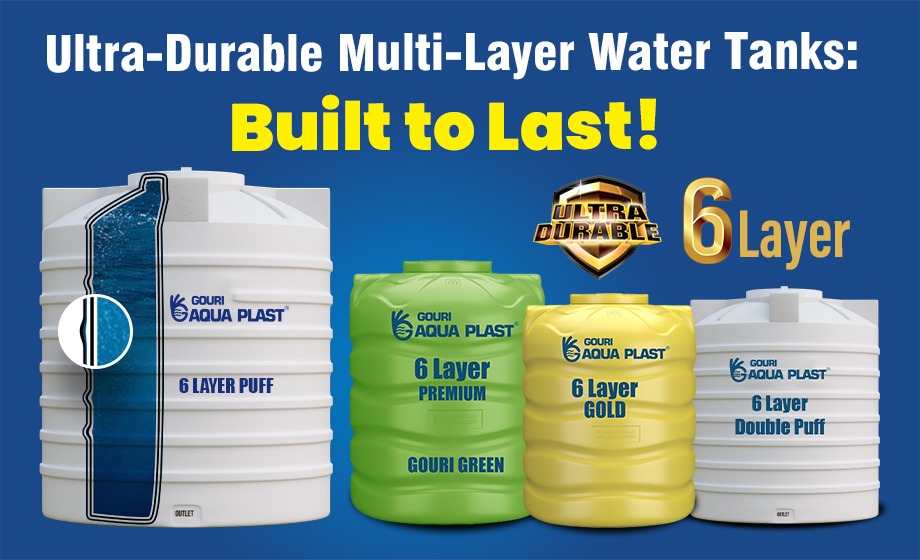In today's world, where water conservation is a growing concern, choosing the right water storage solution is crucial. Multi-layer water tanks offer a compelling option for homes and businesses alike. But what exactly are they, and what advantages do they offer over traditional plastic water tanks?
What are Multi-Layer Water Tanks?
Unlike single-layer plastic tanks, multi-layer water tanks are constructed with several distinct layers, each serving a specific purpose. A typical multi-layer water tank may consist of:
Inner Layer: Crafted from food-grade materials, our tanks ensure the purity and safety of your stored water, meeting stringent standards for quality and hygiene. With its impeccable credentials and commitment to safe water storage, our tanks offer peace of mind with every sip.
Intermediate Layer: This layer, often composed of insulating materials like polyurethane foam, is key to regulating water temperature. It helps to minimize heat transfer, keeping your stored water cooler in summer and warmer in winter. This is especially beneficial in regions with extreme climates.
Outer Layer: The outermost layer, typically made from UV-resistant plastic, shields the tank from the damaging effects of sunlight. This extends the lifespan of the tank and prevents premature degradation caused by sun exposure.
Advantages of Multi-Layer Water Tanks
Now that we understand the basic construction of multi-layer water tank, let's delve into the key advantages they offer:
Superior Temperature Control: As mentioned earlier, the insulating properties of the intermediate layer in these water tanks help regulate water temperature. This is particularly advantageous for storing drinking water, as it prevents significant temperature fluctuations that can impact taste and quality. Additionally, cooler water temperatures in summer can help reduce algae growth, promoting better hygiene.
Enhanced Durability: The robust, multi-layered construction of these tanks makes them considerably more durable than single-layer plastic tanks. They are better equipped to withstand extreme weather conditions, including intense heat, hail, and strong winds. A Six layer water tank, for instance, provides exceptional resilience due to the increased number of protective layers.
Improved Algae Resistance: The insulating properties and UV-resistant outer layer of these water tanks significantly reduce the likelihood of algae growth. This is especially important for storing water for extended periods, as algae can compromise water quality and lead to unpleasant odors.
Versatility and Range of Sizes: These tanks come in a wide range of sizes, from domestic 500 liter to 1000-liter models ideal for homes to much larger industrial tanks suitable for commercial applications.
Cost-Effectiveness: While the initial cost of multi-layer water storage tanks may be slightly higher than single-layer tanks, their extended lifespan, superior insulation, and lower maintenance requirements can translate to significant cost savings in the long run.
- These basic models provide good durability and UV protection.
- Adding an insulating layer improves temperature control for stored water.
- This option incorporates additional insulation for superior temperature regulation.
- The 10 layer gold water tank is meticulously engineered, with each layer serving a distinct purpose to enhance the tank's overall performance.
Basic needs and affordability: A 2-layer water tank offers sufficient UV protection and durability for many applications.
Moderate climates and temperature control: 3 or 4-layer tanks provide good insulation for keeping your water cooler in summer and warmer in winter.
Extreme weather conditions and maximum durability: Consider a 6-layer water tank for the best strength and resilience.
Water Storage Capacity: Consider the volume of water you intend to store. Multi-layer water tanks 1000 L are a popular option for domestic applications, while larger capacities may be required for commercial uses.
Available Space: Ensure you have sufficient space to accommodate the chosen tank size and factor in clearance for installation and maintenance.
Budget: While multi-layer water tanks offer excellent value for money in the long term, consider your initial budget to determine the most suitable option.
Types of Multi-Layer Water Tanks
These water tanks come in various configurations, each offering distinct advantages. Common types include:
The ideal choice depends on your specific needs and budget.
Are Multi-Layer Water Tanks Right for You?
If you're looking for a dependable and long-lasting water storage solution that offers superior temperature control, durability, and algae resistance, then multi-layer water tanks are an excellent choice. They are ideal for storing drinking water, rainwater harvesting, irrigation systems, and various industrial applications.
How many layer water tank is good
The number of layers in a multi-layer water tank depends on your priorities:
Finding the Right Multi-Layer Water Tank
With a variety of sizes and configurations available, selecting the most suitable multi-layer water tank requires careful consideration of your specific needs. Here are some key factors to keep in mind:
By carefully evaluating your requirements and researching the available multi-layer water tank options, you can invest in a water storage solution that meets your needs and provides years of reliable service.
